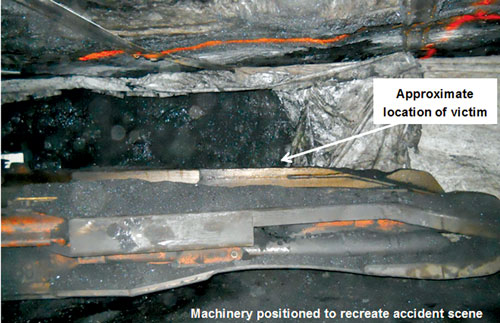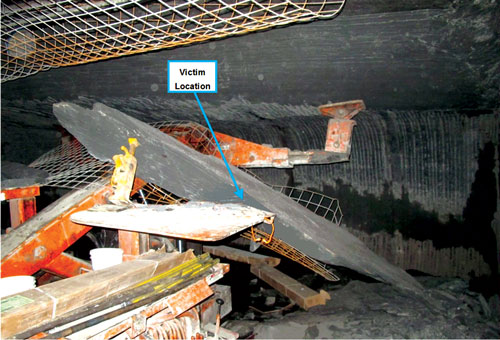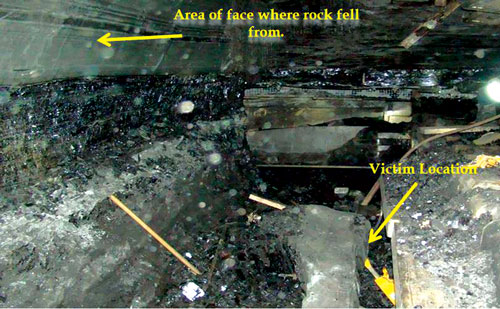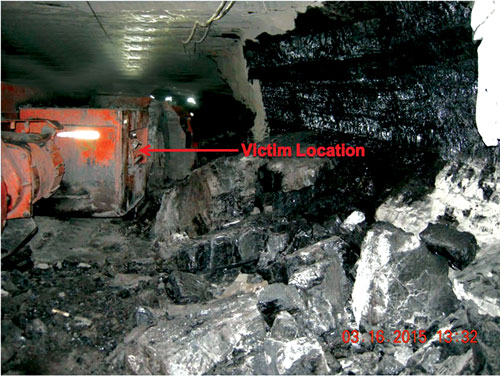Coal’s year-end record quickly shaken by active first quarter
By Donna Schmidt, Field Editor
Any momentum gained as the coal industry left 2014 behind with a record low of fatalities was lost as 2015 began and four fatalities were recorded in a period of just six weeks. All of the deaths occurred underground, and all were recorded at Appalachian operations.
March was the most active month with two fatal incidents, and one of the most alarming trends from the quarter was that nearly all were classified as a fall of the mine roof, back, face or rib.
While none of these fatal events have seen the release of a final investigative report, there is already a good bit of information on each that can be examined, as well as prevention tips to be taken.
Brubaker – January 28
The first death of 2015 occurred just weeks after the holidays; it was the result of a machinery incident at LCT Energy’s Brubaker operation in Somerset County, Pennsylvania, on January 28.
According to a preliminary report issued by the Mine Safety and Health Administration (MSHA), 43-year-old miner operator Rick Kline was crushed when he was pinned between the remote control continuous miner (CM) boom and the right rib at the No. 5 entry at the mine in Hooversville that is owned by JAZ Ventures. The CM he was near was being operated from a remote position in the entry for the next mining cycle when the incident occurred.
Kline, who had 10 years of total experience and more than seven years of experience as a miner operator, had been at the mine just under a year. He was pronounced dead about 90 minutes after the incident.
The death once again placed the implementation and use of proximity protection at center stage when MSHA released its fatalgram report in the weeks following Kline’s passing. Other best practices the agency focused on included the use of low tram speeds and ensuring full visibility of the working area by the CM operator.
 A miner operator was crushed in a machinery incident at LCT Energy’s Brubaker operation in Somerset County, Pennsylvania, on January 28.
A miner operator was crushed in a machinery incident at LCT Energy’s Brubaker operation in Somerset County, Pennsylvania, on January 28.Heilwood – February 20
Just three weeks later and also in Pennsylvania, a roof bolter helper became the nation’s second coal mining death at the Heilwood complex in Heilwood, Indiana County, north of Pittsburgh, and under somewhat similar circumstances. The victim, 29-year-old Todd Trimble, was apparently instantly killed when he was crushed between a piece of roof rock and the top of a drill canopy at the mine’s No. 2 slope entry.
The roof rock that fell measured 3 feet wide, 11.5 ft long, and varied between 3 and 16 in. in thickness.
In a preliminary report released by MSHA the following day, it was revealed that Trimble had been repositioning roof mesh for the upcoming row of roof supports at the time of the accident. He had been working in the mining industry just shy of four years.
As it had been so often before, adverse roof conditions were the focus of MSHA’s best practices that were released in the weeks following the incident in hopes of preventing future similar events. Also at the heart of the agency’s call to action: an effective roof control plan bolt installation pattern, adequate supports for loose roof and ribs, and the correct use and maintenance of the ATRS system on the bolter.
 A roof bolter helper at Rosebud’s Heilwood complex in Indiana County, Pennsylvania, was crushed between a piece of roof rock and the top of a drill canopy in February.
A roof bolter helper at Rosebud’s Heilwood complex in Indiana County, Pennsylvania, was crushed between a piece of roof rock and the top of a drill canopy in February.McElroy – March 8
Just a week into the final month of the year’s first quarter, the first of two deadly accidents was reported in Marshall County in northern West Virginia. The evening of March 8, assistant longwall coordinator John Garloch, 45, was killed at the longwall section of Ohio Valley Resources’ McElroy mine in Cameron.
According to an MSHA preliminary report released the following morning, the victim was supervising in the 12 East longwall section, shoveling loose material from between the longwall face and pan line, when a large piece of rib fell from the face and pinned him to the mine floor. Investigators said that the rock measured 12 feet long by 5 ft. high and 1 ft. thick. Garloch, who was a 12-year mining veteran, was pronounced dead at a local hospital after being pulled from beneath the block.
A majority of federal officials’ best practice tips for prevention included roof and rib control, such as scaling hazardous conditions and conducting thorough examinations of areas for changes and abnormalities. It also urged mines to implement policies, programs, procedures, and controls to protect miners working in the face conveyor areas and to reinstruct all miners in hazard recognition, adequate support methods, and safe work practices when abnormal conditions or circumstances are present on the longwall face.
 On March 8, an assistant longwall coordinator was killed at Ohio Valley Resources’ McElroy mine in Cameron, West Virginia while shoveling loose material from between the longwall face and pan line.
On March 8, an assistant longwall coordinator was killed at Ohio Valley Resources’ McElroy mine in Cameron, West Virginia while shoveling loose material from between the longwall face and pan line.Deep Mine 41 – March 16
The final fatal incident in coal was just a week after the McElroy death, occurring several hours to the south in McClure, Dickenson County, Virginia. Alpha Natural Resources was first to publicly confirm the death of section foreman David Brummitte, 34, at its Paramont Coal Co. Deep Mine 41.
According to its report as well as MSHA’s preliminary findings, the miner, who was performing examination duties at the time, was on the mine’s 003 MMU pillar section in a crosscut between the No. 3 and No. 4 entries when he was struck by a rib roll and pinned against a Joy 10 SC shuttle car.
Brummitte, who had been working in mining 10 years and at Deep Mine 41 for two, was working alone at the time and received blunt force injuries to his right side and upper body. His death was called about two hours after the incident.
While a final report is also still pending in this death, federal investigators did indicate in its fatalgram report in late March that the block that fell on the victim was about 90 in. long, 45 in. high and between 15 and 18 in. in thickness. Much like two of the other fatalities recorded in the quarter, MSHA focused on potential hazard awareness and following approved roof control plans, and also reminded mines that the RCP only contains minimum requirements.
The agency also stressed installation of rib bolts on cycle where needed, and in a consistent pattern, and again to be aware of changing conditions in the roof and rib and to scale when necessary.
 Section foreman David Brummitte was killed at the Paramount Coal Co. Deep Mine 41, owned by Alpha Natural Resources, in a rib roll incident during the first quarter.
Section foreman David Brummitte was killed at the Paramount Coal Co. Deep Mine 41, owned by Alpha Natural Resources, in a rib roll incident during the first quarter.Details Emerge in Some 2014 Final Reports
Of the final investigation reports released in the first quarter of 2015, two of the more anticipated ones included highwalls at mines in Alabama and Kentucky.
The first, released January 9, involved a machinery accident on September 15, 2014 at Black Warrior Minerals’ Manchester surface operation in Jasper, Walker County.
Barry Duncan, a 53-year old bulldozer operator with 28 years of experience, sustained fatal injuries when the bulldozer he was operating went over the edge of an approximately 50-foot highwall. He had been preparing a bench for drilling when the accident occurred.
The drill bench, highwall, and bulldozer were inspected for hazardous conditions, and none were found. The bulldozer was tested for hazardous operating conditions and none were found.
MSHA concluded that the accident had occurred because the bulldozer operator failed to maintain full control of his equipment while it was in motion in close proximity to the edge of an existing highwall. In addition, he said, the victim was not wearing his seat belt where there was a danger of the equipment overturning.
The operator received two citations as a result of the incident, both 104(a)s. The first was for a violation of 30 CFR Section 77.1607(b), stemming from the mine’s failure to ensure the bulldozer operator maintained full control of his machine.
The second citation was for a violation of 30 CFR Section 77.1710(i), as MSHA said that the operator failed to ensure seat belts were used where there is a danger of overturning equipment.
The second report regarded the October 7, 2014 fatal fall of highwall accident at Commonwealth Mining’s Tinsley Branch HWM 61 in Pineville, Bell County, Kentucky, that took the life of nine-year mining veteran Justin Mize.
Mize, with the knowledge of mine management, crawled 37 feet into an unsupported opening that was mined with a highwall mining machine to retrieve a broken cutterhead chain and was crushed by a rock that measured approximately 6 ft. long, 8 ft. wide and 16 in. thick.
“[MSHA] interviews indicated that there were previous occasions when the crew members associated with the operation of this highwall mining machine had entered mine openings,” the agency said in its report. “[One worker] indicated that this was not the first time crew members had entered a highwall mining machine opening to retrieve a chain with the foreman’s knowledge.”
Investigators pointed to mine management in its conclusions of the accident, noting that they had permitted miners to enter the opening without obtaining approval from the MSHA district manager.
“This resulted in fatal crushing injuries to a miner who entered an unsupported highwall mining machine opening…[and] a practice of allowing miners to enter unsupported highwall mining machine openings was permitted by mine management,” the report stated.
In its enforcement actions, MSHA confirmed it handed down a 104(d)(1) citation to Commonwealth Mining following its probe.
“As per 30 CFR 77.1502, no miners are allowed to enter a highwall mining machine opening without a plan approved by the district manager. This violation is an unwarrantable failure to comply with a mandatory standard.”
Another final report released during the first quarter of the year was related to an August 2014 electrical death at CONSOL Energy’s Buchanan operation in Virginia.
In that incident, 41-year-old maintenance supervisor Michael Justice — who had 19 years of mining experience — was killed when he came in contact with an energized component inside an explosion-proof enclosure. The victim had removed the enclosure’s panel cover and was troubleshooting or performing electrical work on a 600 VAC roof bolting machine when he was electrocuted.
“Through interviews and evidence gathered at the scene of the accident, it is believed the victim was working on the energized roof bolting machine’s intrinsically safe (IS) control relay at the time of the accident,” MSHA said in the report released to the public March 5. “It is believed that he was putting the relay retainer bands (two O-rings) on the relay at the time of the accident.
Investigators said that the incident’s root cause was a failure to comply with provisions of the outlines of 30 CFR Section 75.511, a requirement to visually disconnect devices to be locked out and suitably tagged by the persons who perform electrical work.
“The victim did not de-energize, lock out, and tag out the visual disconnecting device on an electrical circuit prior to performing electrical work on that circuit,” the report said. “The non-workmanlike and deficient installation of the conductors on the circuit breaker may have been an indirect cause of the accident. The victim was performing electrical work inside the energized explosion proof enclosure when he came in contact with either the line side connection lug for the red phase lead to the circuit breaker or with strand(s) of No. 2 AWG wires protruding from that connection lug. The company’s programs, policies, and procedures that were in place at the time of the accident failed to prevent this accident.”
As a result of the fatal event, the operator received a 104(d)(1) citation for a violation of that same outline.
Alcohol at Center of Wyoming Death
In late March, MSHA investigators released its final findings from an October 18, 2014 fatal powered haulage accident at Peabody Powder River Mining’s North Antelope Rochelle mine in Wright, Campbell County, Wyoming, revealing that the victim was legally drunk when he drove his rock truck off a highwall.
Darwin Lee Reimer, 51, was operating a Caterpillar 777B when he fell over a 238-ft. highwall while removing top soil ahead of the East Elk Pit at the complex. Reimer was an employee of contractor Dennis McCoy & Sons, Inc.
“The haul truck traveled 2,296 feet over the top soil limit area, through the old top soil berm section (previously stripped), through the cast berm, and through the drill pattern section before it went over the highwall and crashed on the pit bottom,” investigators said.
Testing on Reimer following his death indicated he had been working with a blood alcohol level of 0.093 percent. The legal limit in Wyoming is 0.08. An empty pint whiskey bottle was also found at the scene, near the operator’s compartment.
MSHA concluded in its report that the contractor’s drug and alcohol prevention program did not prevent the victim from driving while having a blood alcohol content that was greater than that allowed by the state of Wyoming. In addition, the victim was not wearing his seat belt, the probe revealed.
Following the incident, mine management held a training meeting with 113 of their contractors in Gillette; the training addressed drug and alcohol policies, detecting depression and risk management. Additional mandatory training began on February 4, 2015 and was scheduled to be held twice monthly.
Additionally, the contractor held extensive retraining classes for all employees on seat belt use while operating mobile equipment and has since developed a written procedure to perform random spot checks.
“Supervisors will perform random visual checks to ensure seat belts are being worn. These checks include subcontractors and all checks will be documented,” MSHA said.
While no citations were issued for the impaired state of the victim, a 104(a) citation was given for a violation of 30 CFR Section 77.403-1(g), which requires seat belt use in areas where there is a danger of overturning and roll protection is provided.

